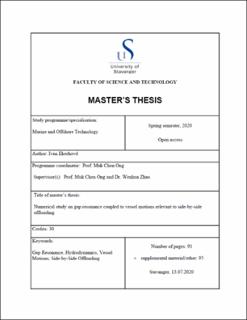| dc.description.abstract | Floating Liquefied Natural Gas (FLNG) systems are large facilities dealing with offshore storage, processing, and transport of natural gas from the ocean basin. These enormous vessels allow the natural gas to be produced closer to the source, creating advantages for gas export as it can be offloaded directly to an LNG carrier at the facility. During the offloading process, where one vessel is moored alongside the other, a long narrow gap is created between them. These side-by-side operations are of limited duration and will not take place in severe sea states. However, at certain frequencies, even calm sea states may excite resonant fluid motions in the gap. For any highly resonant system, the amplitude of the response is dependent on the system damping where the resonance may be excited in a linear or non-linear form. For practical applications, the amplitude of the gap resonance during offshore operations in calm sea has shown to be important by itself or due to coupling with vessel motions. There have been studies on the hydrodynamic performance of the gap resonant phenomenon. It remains unclear how the vessel motions will couple with the gap resonance. To investigate the effect of vessel motions on the gap resonance phenomenon, the a series of numerical simulations based on the linear potential flow solver WADAM are conducted in the present study. The numerical model is validated against experimental data which have been publicly available, where the viscous damping coefficient is calibrated as well. The gap resonances are investigated for various configurations, e.g. fixed + fixed vessels, floating + fixed vessels and floating + floating vessels. The most striking phenomenon is that the first gap resonant peak, which is obtained in the case of two fixed vessels, disappears when one of the two or both vessels are allowed to move freely. It is believed to be a result of the added mass effect from sway and heave motions of the floating vessel. | en_US |
